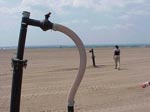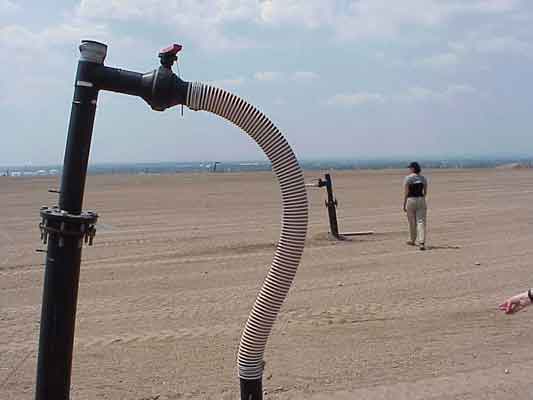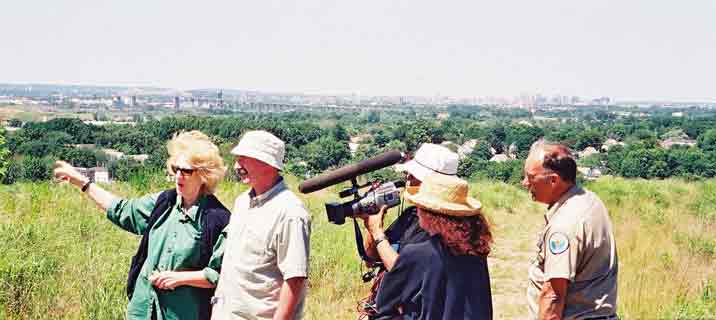

Mierle Laderman Ukeles:Penetration and Transparency:Morphed (with videographers Kathy Brew and Robert Guerra)Art Review by Donald Goddard |
|
|
The installation has two videos projected on opposite walls, north and south walls, I believe. They are tours of the Fresh Kills landfill in Staten Island, shot in the summer of 2001, from the point of view of someone walking, riding, and boating through the landscape, stopping very naturally to look at often incongruous images, closeup and at a distance: water struck by sun, giant earth movers mounting hills of garbage, a heron swooping over an inlet, great platforms of industrial piping. We are immersed in, or surrounded by both nature and technology. We are in the midst of it, willingly but inescapably. And there, in the two small rooms between the projections, are four monitors on which are to be shown video interviews with workers at the landfill, scholars, local residents--people who live with the Kills, who hate it, love it, know a lot about it, care a lot about it, have ideas about it and what to do about it. These presences represent human conscience, our consciousness, between the walls, between the points of the compass, within the landscape that we inhabit and that is so strange to us. |
|
The rooms are in Snug Harbor on Staten Island, in the Newhouse Galleries, part of a show called "Fresh Kills: Artists Respond to the Closure of the Staten Island Landfill." The exhibition opened on October 14, 2001, nearly seven months after Fresh Kills had been officially closed by the City of New York, and a month after suicide terrorists crashed passenger jets into the World Trade Center towers and the Pentagon, killing nearly 5,000 people and destroying the towers. Ukeles' work with the landfill had inspired the original idea for the show four years earlier, and it then developed under curator and director of visual arts Olivia Georgia to include the work of 19 artists, some of it commissioned. Needless to say, the attack of September 11 had an enormous impact on everyone involved. Part of the landfill was reopened on September 13 to receive wreckage from the World Trade Center, inevitably altering the associations and meaning of the works in the show. "Fresh Kills," in the words of a press release from the Snug Harbor Cultural Center, "has been amplified as a symbolic vessel encapsulating who we are, what comprised our past, how we live in the present, and what may constitute the future." |
 |
|
Ukeles refigured her own piece in three parts, asking "is all this footage, shot before September 11, irrelevant?" The first part, to last for the traditional mourning period of 30 days, eliminated all sound and shut down the interviews, out of respect and the need to create a space to listen to each other. The second, which I saw, brought back interviews on two monitors, hoping to "think forward" again. And the third, starting in January, will bring back interviews on the other two monitors. It will also be seen then at the Staten Island Mall, which is adjacent to Fresh Kills. Actually, this is only the beginning of Ukeles' work as the New York City Percent for Art Artist of the Fresh Kills, and its overall title at this early point is Reconnaissance. For the next ten years or so she will be working with ecologists, engineers, park planners, social historians, and others to create something new out of this strange amalgam of water, marsh, woodland, waste, and factory that covers 2,200 acres and has been filling the nostrils and possibly sickening Staten Island residents since 1948. It is the largest dump in the world, but also one of the most interesting places in the world, a juncture of northern and southern vegetation, as NYC Parks Department ecologist Mark Matsil points out, a screen that reveals our public awareness and the space in which we live, in my recollection of the thoughts of Dean Patricia Phillips of SUNY New Paltz. Most consider it a blight and a burden, something that defines where they live more than anything else, and now beyond that a place of indelible trauma. It becomes almost a psychoanalytic project to alleviate the pain. |
|
|
|
If it is to change, if the Kills is to become something that enhances life (further), that relieves people of the burden, everything should be known, and that is precisely how Ukeles approaches the project. She calls it "a journey of learning which leads to multiple paths that open up to shape the future." It is clear throughout that though most of us are fairly oblivious, or even disdainful, of the issues (i.e. what has garbage to do with us?), the people involved with the landfill are, by degrees, passionate, thoughtful, and extremely knowledgeable. All of these meanderings and thoughts Ukeles has brought together create something extraordinary and beyond what it is possible to think of in a line. In several parts of the videos there are computer programs that show up connected to various functions of the giant Kills operation. They weren't imposed as patterns; they grew from the tremendous complex of invention that has emerged to deal with the place, particularly in connection with the complex systems of extracting methane gas and cleaning water of toxins leached from the garbage. It's not shameful; it's a thinking and living process like anything else, and Ukeles somehow clarifies that more than I have ever seen before. Above all, she clarifies the beauty of the process, of people engaged in thought, and of the landscape itself. Donald Goddard © 2001 |

|
|
"Penetration and Transparency" can be seen through February 10, 2002, as part of "Fresh Kills: Artists Respond to the Closure of the Staten Island Landfill at The Newhouse Center for Contemporary Art, Snug Harbor Cultural Center, 1000 Richmond Terrace, Staten Island, NY 10301. Tel. 718 448 2500. |
|
Credits for the Pictures above: Mierle Laderman Ukeles with Kathy Brew and Roberto Guerra "PENETRATION AND TRANSPARENCY: MORPHED", a work in Three Parts 2001. Six channel video installation, two full wall projections and 4 monitors placed in two adjoining galleries. Dimensions variable. Courtesy Ukeles' New York City Percent for Art Artist of the Fresh Kills Landfill Phase I. |
Art Reviews Listings - Previous Review - Next Review
Art Review - NYArtWorld.com - NYAW.com. All artwork is copyright of the respective owner or artist. All other material © Copyright 2015 New York Art World ®. All Rights Reserved.
New York Art World ® - Back to Top